#015: Characteristics of Division Glomeromycota
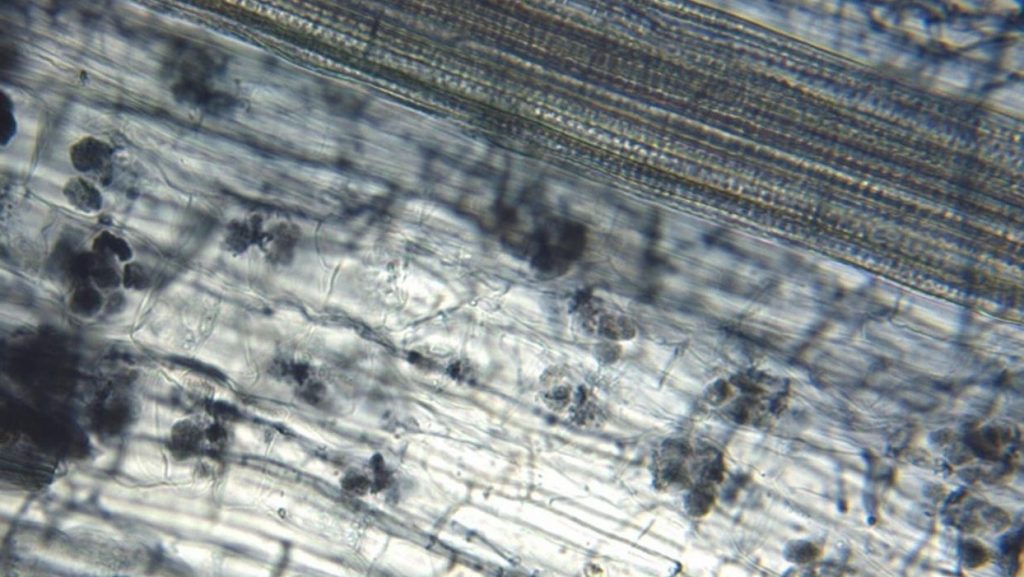
Glomeromycota include all arbuscular mycorrhizal fungi. The dark spots in this photo are branching structures called arbuscules that are typical of this type of mycorrhiza. Public Domain image.
The Glomeromycota are unusual and poorly understood organisms. Fungi from this division rarely produce easily visible structures and cannot be grown without a plant host, so investigating them is very difficult. Glomeromycotan fungi are some of the most important fungi on Earth because they form arbuscular mycorrhizas, which provide essential nutrients to the vast majority of terrestrial plants.1
Ecology
The major unifying characteristic of fungi in Glomeromyocta is their ecological role. All glomeromycotans form arbuscular mycorrhizas (AM) with various terrestrial plants (see FFF#074 for a full discussion of AM). The one exception to this rule – since there is always an exception when it comes to fungi – is Geosiphon pyriformis, which is symbiotic with cyanobacteria instead. Unlike some mycorrhizal fungi, the Glomeromycota are obligate symbionts, meaning they cannot survive without their photosynthetic partner. Consequently, they cannot be grown in a lab unless they are provided with a suitable host.1
Mycorrhizas are a type of mutualism between a fungus and a plant where the fungus gives the plant nutrients (especially phosphorous) in exchange for sugars produced through photosynthesis.1,2 AM fungi facilitate this relationship by forming structures within the plant’s root cells while not causing a disease reaction.1 Most land plant species form AM; the ones that do not usually form ectomycorrhizas but a few plant families are nonmycorrhizal (see FFF#073 for more on other types of mycorrhizas). AM fungi tend to be generalists, colonizing a variety of different plant species. Likewise, each AM plant is usually colonized by multiple species of Glomeromycota.1 This results in a network that allows plants to share nutrients and even communicate with one another.2,3 Because so many plants rely on them, the Glomeromycota are some of the most abundant soil fungi and are found in diverse habitats all across the globe.4
Morphology
The Glomeromycota produce very few structures. Inside mycorrhizal roots, they form hyphae, arbuscules, and sometimes vesicles. In the soil, they form distributive hyphae, absorptive hyphae, and spores. These structures all have very few observable features, but mycologists can use them to identify organisms down to species. It also helps to know the mycorrhizal partner and soil conditions such as pH.5
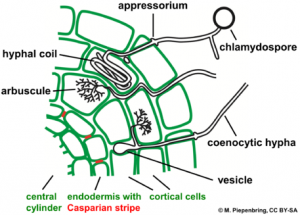
Diagram of an arbuscular mycorrhiza. Photo by M. Piepenbring [CC BY-SA 3.0], via Wikimedia Commons (cropped).
Regardless of the type of hyphae, the AM fungus must penetrate a root cell and form a structure called an ‘arbuscule’ in order to exchange nutrients. Arbuscules are highly branched intracellular structures formed by the fungus. They have a very high surface area, which allows for an efficient exchange of nutrients and sugars. The degree and pattern of branching varies slightly among species.5
After the fungus has established arbuscules, some glomeromycotans form structures called ‘vesicles’. A vesicle is an inflated area of the hypha that functions as a storage structure. In some species, these resemble spores and may also function like spores. Vesicle presence or absence, position, and morphology are variable and can help identify the species of fungus.5
Outside the root, most fungal structures are designed for nutrient acquisition. Distributive hyphae are relatively large and branch infrequently; their primary purpose is to connect different parts of the fungus together. Absorptive hyphae are thin, short, and highly-branched and are used to extract nutrients from the soil. Neither of these types of hyphae is easily separated from the soil, so they are not useful for identification.5
Reproduction
Perhaps the most bizarre feature of the Glomeromycota is that they reproduce only asexually. Years of research have failed to find any sexual reproductive structures or any DNA evidence of sexual reproduction.1 For an entire Division or Phylum to rely solely on asexual reproduction is almost unheard of among eukaryotes. Recombination of genes through the process of sexual reproduction helps evolution remove harmful genes and promote beneficial ones. That the Glomeromycota could abandon sexual reproduction hundreds of millions of years ago and yet remain some of the most successful fungi on the planet is simply astounding.
Since the Glomeromycota do not do sexual reproduction, each individual should contain only genetically identical nuclei. However, some genetic studies suggest that this is not the case and instead they have multiple genetically distinct nuclei. This has not been definitively proven, but it still could complicate efforts to use DNA to investigate reproduction.1
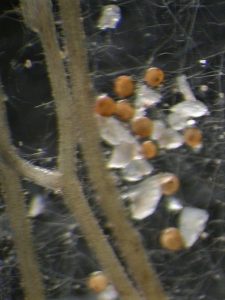
The brownish circles are spores of a glomeromycotan fungus. Notice how large they are; the spores are nearly the same diameter as the root! Photo by Mike Guether [GFDL or CC BY 3.0], via Wikimedia Commons (cropped).
Glomeromycotan spores have more morphologically variable features than any of the other structures produced by these fungi, so they are invaluable when identifying species. These spores have extremely thick cell walls that are often composed of multiple layers.1 They all have at least one cell wall, but some species have as many as four distinct walls.7 The outermost wall also varies in color and texture: spores can range from smooth to bumpy and from clear to dark brown.5 Additionally, the processes of spore formation and germination differ between species and can be used to identify specimens.7 For details about morphological differences in glomeromycotan spores, see this paper.
When conditions are right, the spore germinates and grows a short hypha in an attempt to find a suitable root host. If none is found, the nascent fungus retreats back into the spore and waits to try again later.1
Taxonomy and Evolution
Glomeromycota was only recently established as a division; it was separated from the old polyphyletic division Zygomycota in 2001.1,8 Thanks to DNA technology, mycologists now know that the Glomeromycota are more closely related to the Dikarya (Ascomycota and Basidiomycota). The Glomeromycota probably split from Dikarya around 600 million years ago (Dikarya split into Ascomycota and Basidiomycota sometime after that).1,9
Fossils of early glomeromycotan fungi date as early as 400 million years ago and correspond with the evolution of land plants. Indeed, taxonomic relationships suggest that the common ancestor of all land plants formed arbuscular mycorrhizas. Both of these lines of analysis suggest that the Glomeromycota were crucial in helping plants colonize the land (for more on the evolution of mycorrhizas, see FFF#078).1
There is a surprising lack of diversity within the Glomeromycota, especially considering how widespread the organisms are. Glomeromycota contains about 150 species divided up among 4 orders, 11 families, and 27 genera.1,10 However, species of Glomeromycota were primarily established using spore morphology until DNA analysis tools became widely available. It seems likely that genetic data will necessitate creating many new species to support hidden genetic diversity.1
| Kingdom | Fungi |
| Division | Glomeromycota C. Walker & A. Schüßler8 |
| Class | Glomeromycetes10 |
| Order
(Families) |
Glomerales
(Glomeraceae, Claroideoglomeraceae)10 |
| Diversisporales
(Gigasporaceae, Acaulosporaceae, Pacisporaceae, Diversisporaceae, Sacculosporaceae)10 |
|
| Paraglomerales
(Paraglomeraceae)10 |
|
| Archaeosporales
(Geosiphonaceae, Ambisporaceae, Archaeosporaceae)10 |
See Further:
http://tolweb.org/Glomeromycota
https://mycorrhizas.info/vam.html
http://website.nbm-mnb.ca/mycologywebpages/NaturalHistoryOfFungi/Glomeromycota.html
Citations
- Redecker, D. Glomeromycota. Arbuscular mycorrhizal fungi and ther relative(s). Tree of Life Web Project (2008). Available at: http://tolweb.org/Glomeromycota. (Accessed: 2nd June 2017)
- Brundrett, M. Roles of Mycorrhizal Associations. Mycorrhizal Associations: The Web Resource (2008). Available at: https://mycorrhizas.info/roles.html. (Accessed: 2nd June 2017)
- Fungus network ‘plays role in plant communication’. BBC News (2013).
- Malloch, D. Glomeromycota. The Mycology Web Pages Available at: http://website.nbm-mnb.ca/mycologywebpages/NaturalHistoryOfFungi/Glomeromycota.html. (Accessed: 2nd June 2017)
- Brundrett, M. Arbuscular Mycorrhizas. Mycorrhizal Associations: The Web Resource (2008). Available at: https://mycorrhizas.info/vam.html. (Accessed: 2nd June 2017)
- Pleasants, J. M. et al. Corn pollen deposition on milkweeds in and near cornfields. Proc Natl Acad Sci U S A 98, 11919–11924 (2001).
- Oehl, F., Sieverding, E., Palenzuela, J., Ineichen, K. & Alves da Silva, G. Advances in Glomeromycota taxonomy and classification. IMA Fungus 2, 191–199 (2011).
- Glomeromycota. Mycobank Available at: http://www.mycobank.org/Biolomics.aspx?Table=Mycobank&Rec=374517&Fields=All. (Accessed: 2nd June 2017)
- Blackwell, M., Vilgalys, R., James, T. Y. & Taylor, J. W. Fungi. Eymycota: mushrooms, sac fungi, yeast, molds, rusts, smuts, etc. Tree of Life Web Project (2012). Available at: http://tolweb.org/Fungi/2377. (Accessed: 2nd June 2017)
- Schüßler, A. Taxonomy. Glomeromycota Phylogeny (02 Jan 13). Available at: http://www.amf-phylogeny.com/amphylo_taxonomy.html. (Accessed: 2nd June 2017)


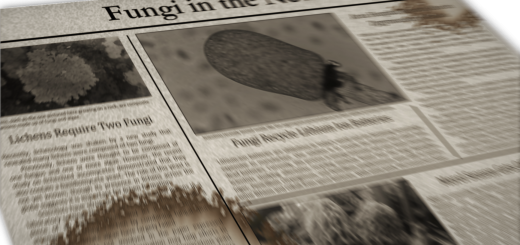
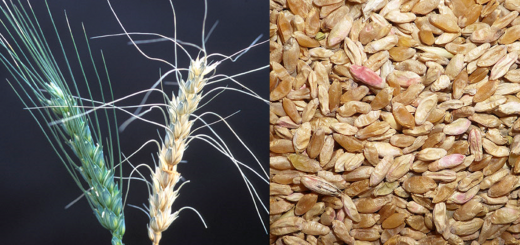





![#011: Characteristics of Kingdom Fungi [Archived]](https://www.fungusfactfriday.com/wp-content/themes/hueman/assets/front/img/thumb-small-empty.png)

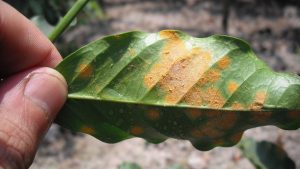
2 Responses
[…] to date the evolution of AM. This analysis suggests that the Glomeromycota (fungi that form AM, FFF#015) evolved between 353 and 465 mya. There is some fossil evidence to back this up: fossilized […]
[…] are the most abundant type of mycorrhizae on earth. In AM, fungi from the phylum Glomeromycota (FFF#015) penetrate plant root cells and grow arbuscules (tree-shaped structures designed to facilitate […]